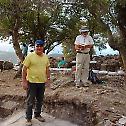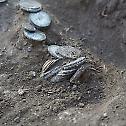Archaeologists unearth church believed to mark home of Apostles Peter and Andrew
Archaeologists, from the Kinneret Academic College and Nyack College of New York believe they have unearthed the Church of the Apostles that, according to Tradition, was built on the site of the home of the great apostles Sts. Peter and Andrew.
The village of Bethsaida, where the brothers lived, is today part of the Bteikha Nature Reserve by the Sea of Galilee, reports Haaretz.
What is absolutely certain is that the excavators uncovered a large Byzantine-era church with indicative gilted glass tesserae. “Those are for wall mosaics and only appear in churches,” explained Professor R. Steven Notley from Nyack College. From above, the building is seen to have an east-west axis and the division into a central nave with two aisles, which also identifies it as a church.
Marble fragments from the iconostasis were also found, as well as mosaic flooring and roof tiles characteristic of large buildings, and a fragment of a chalk carving featuring a cross.
Speaking to the belief that they found precisely the Church of the Apostles, Notley told Haaretz: “It’s the historical tradition we possess, and there is no good reason to question it,” referring to the account of the Bavarian bishop Willibald who visited the Holy Land in 725 and wrote about seeing the church that marked the site of the apostles’ home while walking from Capernaum to Kursi.
This is the only church found between those two towns, the archaeologists explain, and it seems to be of the appropriate time period. Moreover, the church was found near remnants of a Roman-era settlement, matching the location of Bethsaida as described by the 1st century AD Roman historian Flavius Josephus, Professor Mordechai Aviam from Kinneret Academic College told the Times of Israel.
Based on more than 100 coins found, the church seems to have been built in the 5th century and abandoned in the late-7th or 8th century. However, the identification of the church will remain theoretical until definitive proof is found, such as an inscription. “It would be normal to find an inscription in a church of the Byzantine period, describing in whose memory it was built, for instance,” Prof. Notley said.
The responsible archaeologists, Professors Notley and Aviam, have long believed that the present-day village of el-Araj is the Biblical Bethsaida, though the fact that no church had previously been found there made others doubt the identification. “Now we have a church right where the pilgrims say was a church. The early testimonies about the church over Peter’s house described it as a basilica. Would a Byzantine describe an eight-sided structure as a basilica? This is a question that needs to be addressed more fully,” Notley said.
Source: Orthochristian.com










